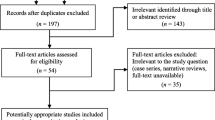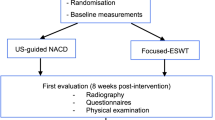Abstract
Background
There are several treatment options for calcifying tendinitis of the shoulder. The next step treatment after conservative treatment fails is still a matter of dispute. Extracorporeal shock wave therapy (ESWT) has been shown to be a good alternative to surgery, but the best treatment intensity remains unknown. High-energy ESWT is much more painful, more expensive, and usually is done in an inpatient setting, whereas low-energy ESWT can be performed in an outpatient setting by a physical therapist.
Questions/purposes
A systematic review and meta-analysis of randomized trials was performed to answer two clear research questions: (1) Is there a greater increase in the Constant-Murley score in patients treated with high-energy ESWT compared with those treated with low-energy ESWT by 3 months and by 6 months? (2) Is there a greater chance of complete resorption of the calcifications in patients treated with high-energy ESWT compared with those treated with low-energy ESWT by 3 months and by 6 months?
Methods
Five relevant electronic online databases, Medline (through PubMed), EMBASE (through OVID), Cinahl (through EBSCO), Web of Science, and the Cochrane Central Register of Controlled Trials, were systematically searched. We also crosschecked the reference lists of articles and reviews for possible relevant studies. Eligible for inclusion were all randomized controlled trials (RCTs) that compared high-energy ESWT (> 0.28 mJ/mm2) with low-energy ESWT (< 0.08 mJ/mm2). One author examined titles and abstracts of each identified study to assess study eligibility. Two reviewers independently extracted data and assessed the risk of bias and study quality. The primary outcome measure, the Constant-Murley score, was assessed by comparing mean functional outcome scores between the groups. Secondary outcomes were assessed using odds ratios, when appropriate data were pooled. Based on this process, five RCTs (359 participants) were included.
Results
All five RCTs showed greater improvement in functional outcome (Constant-Murley score) in patients treated with high-energy ESWT compared with patients treated with low-energy ESWT at 3 and 6 months. The 3-month mean difference was 9.88 (95% CI, 9.04–10.72, p < 0.001; 6-month data could not be pooled). Furthermore, high-energy ESWT more often resulted in complete resorption of the deposits at 3 months. The corresponding odds ratio was 3.40 (95% CI, 1.35–8.58) and p = 0.009 (6-month data could not be pooled).
Conclusion
When shock wave therapy is chosen, high-energy shock wave therapy is more likely to result in improved Constant-Murley score and resorption of the deposits compared with low-energy therapy.
Level of Evidence
Level I, therapeutic study. See the Instructions for Authors for a complete description of levels of evidence.







Similar content being viewed by others
References
Albert JD, Meadeb J, Guggenbuhl P, Marin F, Benkalfate T, Thomazeau H, Chalès G. High-energy extracorporeal shock-wave therapy for calcifying tendinitis of the rotator cuff: a randomised trial. J Bone Joint Surg Br. 2007;89:335–341.
Conboy VB, Morris RW, Kiss J, Carr AJ. An evaluation of the Constant-Murley shoulder assessment. J Bone Joint Surg Br. 1996;78:229–232.
Constant CR, Gerber C, Emery RJ, Sojbjerg JO, Gohlke F, Boileau P. A review of the Constant score: modifications and guidelines for its use. J Shoulder Elbow Surg. 2008;17:355–361.
Constant CR, Murley AH. A clinical method of functional assessment of the shoulder. Clin Orthop Relat Res. 1987;214:160–164.
Diehl P, Gerdesmeyer L, Gollwitzer H, Sauer W, Tischer T. [Calcific tendinitis of the shoulder] [in German]. Orthopade. 2011;40:733–746.
Durst HB, Blatter G, Kuster MS. Osteonecrosis of the humeral head after extracorporeal shock-wave lithotripsy. J Bone Joint Surg Br. 2002;84:744–746.
Furlan AD, Pennick V, Bombardier C, van Tulder M; Editorial Board, Cochrane Back Review Group. 2009 updated method guidelines for systematic reviews in the Cochrane Back Review Group. Spine (Phila Pa 1976). 2009;34:1929–1941.
Gartner J, Heyer A. [Calcific tendinitis of the shoulder] [in German]. Orthopade. 1995;24:284–302.
Gerdesmeyer L, Wagenpfeil S, Haake M, Maier M, Loew M, Wortler K, Lampe R, Seil R, Handle G, Gassel S, Rompe JD. Extracorporeal shock wave therapy for the treatment of chronic calcifying tendonitis of the rotator cuff: a randomized controlled trial. JAMA. 2003;290:2573–2580.
Gosens T, Hofstee DJ. Calcifying tendinitis of the shoulder: advances in imaging and management. Curr Rheumatol Rep. 2009;11:129–134.
Higgins JP, Green S, eds. Cochrane Handbook for Systematic Reviews of Interventions. The Cochrane Collaboration; 2011. Available at: http://handbook.cochrane.org. Accessed January 4, 2014.
Hofstee DJ, Gosens T, Bonnet M, De Waal Malefijt J. Calcifications in the cuff: take it or leave it? Br J Sports Med. 2007;41:832–835.
Huisstede BM, Gebremariam L, van der Sande R, Hay EM, Koes BW. Evidence for effectiveness of Extracorporal Shock-Wave Therapy (ESWT) to treat calcific and non-calcific rotator cuff tendinosis: a systematic review. Man Ther. 2011;16:419–433.
Hurt G, Baker CL Jr. Calcific tendinitis of the shoulder. Orthop Clin North Am. 2003;34:567–575.
Ioppolo F, Tattoli M, Di Sante L, Venditto T, Tognolo L, Delicata M, Rizzo G, Di Tanna G, Santilli V. Clinical improvement and resorption of calcifications in calcific tendinitis of the shoulder after shock wave therapy at 6 months’ follow-up: a systematic review and meta-analysis. Arch Phys Med Rehabil. 2013;94:1699–1706.
Kukkonen J, Kauko T, Vahlberg T, Joukainen A, Aärimaa V. Investigating minimal clinically important difference for Constant score in patients undergoing rotator cuff surgery. J Shoulder Elbow Surg. 2013;22:1650–1655.
Loew M, Daecke W, Kusnierczak D, Rahmanzadeh M, Ewerbeck V. Shock-wave therapy is effective for chronic calcifying tendinitis of the shoulder. J Bone Joint Surg Br. 1999;81:863–867.
Loew M, Jurgowski W, Mau HC, Thomsen M. Treatment of calcifying tendinitis of rotator cuff by extracorporeal shock waves: a preliminary report. J Shoulder Elbow Surg. 1995;4:101–106.
Moher D, Cook DJ, Eastwood S, Olkin I, Rennie D, Stroup DF. Improving the quality of reports of meta-analyses of randomized controlled trials: the QUOROM statement. QUOROM Group. Br J Surg. 2000;87:1448–1454.
Mouzopoulos G, Stamatakos M, Mouzopoulos D, Tzurbakis M. Extracorporeal shock wave treatment for shoulder calcific tendonitis: a systematic review. Skeletal Radiol. 2007;36:803–811.
Pleiner J, Crevenna R, Langenberger H, Keilani M, Nuhr M, Kainberger F, Wolzt M, Wiesinger G, Quittan M. Extracorporeal shockwave treatment is effective in calcific tendonitis of the shoulder: a randomized controlled trial. Wien Klin Wochenschr. 2004;116:536–541.
Rompe JD, Burger R, Hopf C, Eysel P. Shoulder function after extracorporal shock wave therapy for calcific tendinitis. J Shoulder Elbow Surg. 1998;7:505–509.
Speed CA, Hazleman BL. Calcific tendinitis of the shoulder. N Engl J Med. 1999;340:1582–1584.
Vavken P, Holinka J, Rompe JD, Dorotka R. Focused extracorporeal shock wave therapy in calcifying tendinitis of the shoulder: a meta-analysis. Sports Health. 2009;1:137–144.
Author information
Authors and Affiliations
Corresponding author
Additional information
Each author certifies that he or she, or a member of his or her immediate family, has no funding or commercial associations (eg, consultancies, stock ownership, equity interest, patent/licensing arrangements, etc) that might pose a conflict of interest in connection with the submitted article.
All ICMJE Conflict of Interest Forms for authors and Clinical Orthopaedics and Related Research editors and board members are on file with the publication and can be viewed on request.
Electronic supplementary material
Below is the link to the electronic supplementary material.
About this article
Cite this article
Verstraelen, F.U., in den Kleef, N.J.H.M., Jansen, L. et al. High-energy Versus Low-energy Extracorporeal Shock Wave Therapy for Calcifying Tendinitis of the Shoulder: Which is Superior? A Meta-analysis. Clin Orthop Relat Res 472, 2816–2825 (2014). https://doi.org/10.1007/s11999-014-3680-0
Received:
Accepted:
Published:
Issue Date:
DOI: https://doi.org/10.1007/s11999-014-3680-0




